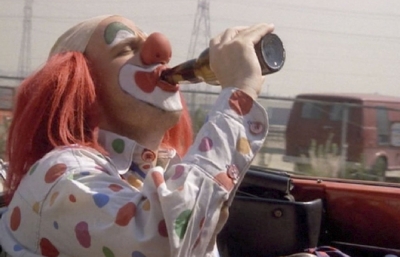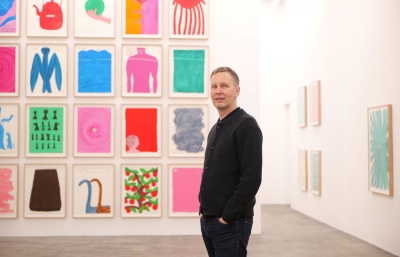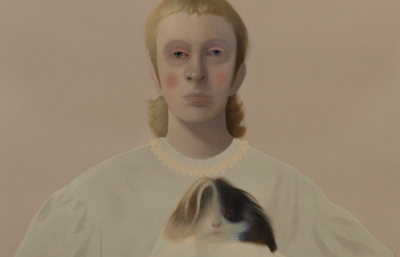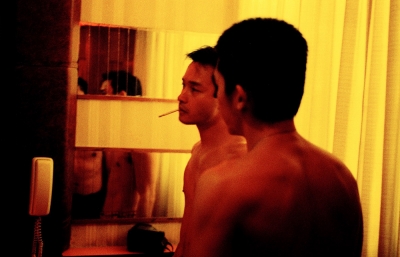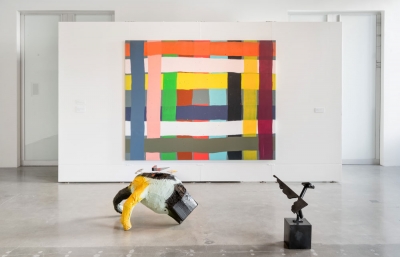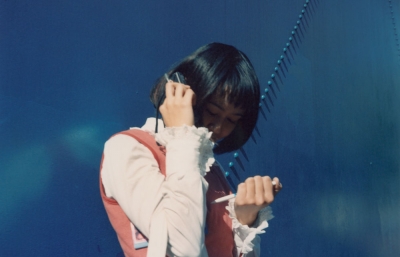Attending a screening of his latest film, 20th Century Women, I laughed out loud with the rest of the audience more times than I can count, sang along to many of the soundtrack songs and found my eyes welling up. When I, admittedly a little nervous, met Mike at his Los Angeles studio a few days later, an easy conversation began as soon as I walked through the door.
I was a senior in high school when Deformer came out. The film about skateboarder Ed Templeton and his wife Deanna had a revelatory style and narration, and I never forgot it. It was my first introduction to the vastly creative, multidisciplinary artist Mike Mills. While his last two feature films, Thumbsucker and Beginners, have become what he is most known for, his multi-media creative output has been expansive for over two decades.

Portrait of Mike Mills by Austin McManus
Highlights include designing for the now cult clothing company X-Girl, as well as album covers and T-shirts for The Beastie Boys and Sonic Youth. Mills has directed music videos for Air, Moby, Blonde Redhead and Yoko Ono, and with Roman Coppola, he co-founded a highly influential production company, The Directors Bureau. Attending a screening of his latest film, 20th Century Women, I laughed out loud with the rest of the audience more times than I can count, sang along to many of the soundtrack songs and found my eyes welling up. When I, admittedly a little nervous, met Mike at his Los Angeles studio a few days later, an easy conversation began as soon as I walked through the door. -Austin McManus
Read this feature and more in the January 2017 issue of Juxtapoz Magazine.
Austin McManus: Before this film, I didn’t know the phrase “Black Flag Art Fag,” but I was really into Black Flag as a kid. As one of a couple skateboarders at school, I remember having to fight all the time. I just remember being an outcast focused on skateboarding. Is that something that you made up?
Mike Mills: It's really hard to describe to people how uncool skating was. People would ask, “Why do you spend all your time doing that?” In Santa Barbara, the skate park was connected to a mini golf place, like they often were. Batting cages, mini golf, and then a bad skate park. I remember one of the first times I wore red and blue low-top Vans, in the late ’70s at Santa Barbara High School, jock dudes would come up and want to get into a fight about your clown shoes.

Album artwork for Sleater-Kinney, No cities to Love (2015)
I can totally relate to that.
Then, once you start dying your hair and stuff, you got hit walking down the hallway. Like blind sucker punched. Or you would get chased around the parking lot by the Rolling Stones stoner dudes, ha ha. My horrible band would play at my then-girlfriend's house, and the combo of guys wearing white felt jackets and stoner dudes (the jock dudes could hang out with the Rolling Stones; we called them hicks back in the day, but they weren't hicks—hesher kind of guys, pre-heavy metals, on their way to being heavy metal dudes) came in, and we were wimpy, me and my emo friends. They beat us up while we were playing. One guy punched my guitar player in his hand, right into his guitar!
Did he get hurt?
Yeah! And the sound was also pretty amazing. They just mowed us down. Anyway, back to the art fag thing, a couple bands down the road, I was with these older guys, and we would play at Baudelaire’s in Santa Barbara, which I tried to recreate in the film. I was underage. I was in the band so I could kind of sneak in, and of course, drink my ass off. We were influenced by Bauhaus and Joy Division and all that. I didn't love Black Flag, but I loved hardcore stuff. I loved Adolescents. There was a punk house kind of thing right next to Santa Barbara where a lot of the guys that would become the Cito Rats and RKL hung out. Because I played in that band and hung out with these guys who were more cultured, the kids disliked me for being sort of pretentious. And they're not wrong, I was pretentious. They spray painted my name and a bad picture of me, and said art fag and stuff. Art fag was a term, like Jack from T.S.O.L. got called an art fag.

Album artwork for The Beastie Boys, Hot Sauce Commitee Part Two (2011)
I was called skater fag. Anything with “fag,” basically.
Yeah, bad news. So that's where it came from. You know how I have Koyaanisqatsi in the movie?
Yes, love that movie. Love all of Godfrey Reggio’s movies.
Right. So I was really lucky to get it in the movie and it illustrates what's going on in the car speech when the kid runs away to L.A. and goes to the Circle Jerks show that's in The Decline of Western Civilization. I even played with putting him in the audience, Forrest Gump style.
But then I ended up playing a few minutes of Decline and put the title on it. We all thought I was honoring this movie, but Penelope [Spheeris, director of Decline] just so didn't get my movie. I forgot how she phrased it, she was really nice. She watched it, and at first was like, “No.” And I wrote her back—we have a mutual friend who tried to get her to write me. I'm not dissing her at all, but it's interesting in the context of punk history. Basically her deal was that I totally did not understand the punk scene and unconsciously misunderstood what it was about. I still don't know exactly what she meant, but she has a hell of a lot more credit than I do. I felt like, fuck, I was thrown back into Santa Barbara. I'm the suburban Santa Barbara poser kid! I have oodles of respect for her and that movie, but it was interesting to get shunted like that.
This movie is loosely autobiographical, much like Beginners. Why do you create work based on your own experiences? Is it cathartic, gaining new perspectives?
I've been going to therapy since I was 28. That's cathartic. My parents died before I wanted them to. I was in my thirties when they both died. Because they were born in the twenties, those kinds of people, they don't talk about their feelings or backgrounds. I miss them. I always wanted more of them. To sort of commune with them, even as ghosts, even as film character ghosts; there's some Oxycontin vibes to that. It's nice. It's comforting. It feels meaningful. It's not this revelatory thing, like, "I never knew this!" By the time you're making a film, you've been writing a script for three years, presenting it to the world. Look at Ginsberg's Howl, the way that's definitely his life and daily shit, and he elevates it into this epic poem. Or Fellini’s 8½; that's his life, the parts of his life that he hasn't figured out. But he's presenting it to us. It gives it a grip, you know? Maggie Nelson's book The Argonauts, that's her life and struggles. I just feel it's more valuable, more like collage. I like real life, real people, trying to capture somebody, though ultimately I don't feel that's really possible. On the written page, the script of 20th Century Woman is based on my parents, but it'd be wrong to say that's all it is.
My sisters would do a different version, and obviously, my parents would do a really different one. I could even do other versions. Last night, I thought, “Oh fuck, what am I going to do next? I don't know anything.” Just to fuck with everybody, I could do these two films over again, completely different, just to show that we’re all so complicated, paradoxical and layered. I could show you a totally different way of my dad coming out late in life or my mom's weird openness and closeness.
Everyone in your films seems like they're trying to figure out how to navigate life, but no one really has many answers. They're looking somewhere and everywhere, whether it's in people or other aspects of life. I find that fascinating.
That's nice. For me, that’s really related to therapy. I think they're all trying to figure out, what's the story I've been telling myself about myself? How did I get that story? How is it wrong and how was it maybe right? How is it putting me in a prison of my own making? Everyone's trying to get away from their false self and trying to find something else. I think that's nearly impossible. It's an inevitably failed project that everyone engages, that I'm engaging. So, of course, all my little claymation people do the same thing I do. That's my trip. With this movie, I didn't plan it, but I could smell it happening. I saw, oh, they're really different from each other, the people don't really belong together. Even the mother and son, they're the wrong ages and she's in the wrong time period, like Humphrey Bogart meets punk. They're not supposed to be together but they're helping each other. They're figuring out who they are through their relationship to this other person who they maybe really shouldn't be with, or are going to end up with, or they have as much different as they have in common. That concept became really interesting. You don't always know what you are writing for a long time, and it wasn’t until I was deep in that I was like, “Ohhh.” There's a great BARR song that goes, “Who am I in relation to you, and who are we in relation to the other kids?” That's a Brendan Fowler lyric. That’s kind of my movie.
One of my favorite aspects of the movie, something you also did in Beginners, are the still image collages. They brought a new experience and are a great way to integrate your graphic design into live action. When did you decide to start using still images like that?
A long time ago, I did a music video for a band called Pond and it was all stills. I've done some ads like that also. I love stills. Maybe it’s from doing graphics and coming from a 2D art world, like Chris Marker or Godard. You know who does it? It's not stills, but historical footage. Tarkovsky's The Mirror is an amazing movie, like Russian avant-garde. For every film snob nerd, he's way up there. I just watched it again and was like, "Holy shit. He did it." It adds this really cool friction. The stills add this weird kinetic-ness, especially when you go through a lot of them quickly. But with Beginners and the new one, I really wanted to show the historical lineage of how we got to this place. I wanted to situate my fictional characters and bump them up against reality. When the kid runs away to L.A. and you see all those pictures of a Masque-centric version of the L.A. punk scene, I really love the frisson of that. It’s not just this character, it's this scene, the culture. It makes it more real, and contradictorily, points out that my film's a fiction and the character's a construction is sort of a Godardian trick. I like going back and forth and spending time making the characters as real as I can. We have amazing photos, Joseph Szabo, Richard Verdi and Jenny Lens photos. I wish I could have labeled each, but they're going so fast and there's so many different photographers. I love putting the labels on the books like Koyaanisqatsi and the Carter speech, and having that in the movie. I'm trying to make a book or a zine with just the punk photos in the movie and then more from each photographer.
I wonder how you came up with the dialogue. The obvious one to mention is when Annette Bening's character says, "This is the really hard part. And then it gets better. And then it gets hard again.” And, “Look, wondering if you're ever happy—it’s a great shortcut to just being depressed." My personal favorite is Greta Gerwig's "Whatever you imagine your life's going to be like, know your life's not going to be anything like that."
They’re just my little therapized self talking. Annette has a lot of zingy one-liners. My mom was a little like that. My mom was really great. I'd come down in all my punk regalia, and she'd go, "Did you mean to get dressed like that, or did this happen to you?" She was really great at wise cracking. My mom loved Humphrey Bogart, and she looked even more butch than Annette in the movie. Hard drinking, hard smoking, Humphrey Bogart-ish woman, you know? She’d say, "In my next life I'm going to marry Bogart," like in the movie. So I started watching a lot of Bogart to help me figure out how my mom talked or what her sense of humor was. And those movies, Stage Door and To Have and Have Not, and even The Thin Man movies, all William Powell's, they're filled with such ironic, sarcastic, anti-authoritarian, funny-as-shit lines. The women had stronger lines than they do now. ’30s America was a much more socialist, anti-authoritarian, anti-upper class place, and that's very much my mom's sense of humor. She loved to diss the rich, loved to mess with dudes. In a lot of ways, this is part of my portrait of my mom. She had these one-liners very much out of the pre-code films, and then there's sort of life-y truth shit in there that is, like you said, people trying to figure out how to be a human or how to be somewhat free, so they end up having those kinds of conversations.
And the funny parts too, they were all evenly distributed. The scene where they're trying to understand Black Flag and the Talking Heads and they're dancing. I've heard my mother say those same things when I played Adolescents or Wasted Youth.
My mom used to let my band practice at our house and she'd come listen sometimes, and she took it really seriously. We would go play somewhere, and she and my dad would come, dressed up, to our dumb punk show.

Portrait of Mike Mills by Austin McManus
Dressed up how?
Like they were going to the theater. My dad always wore a suit and tie, and my mom, some female version, because my dad's an art historian and museum director, and my mom's very art adjacent. I think she wanted to be an architect and a pilot. Ideally an architect who flies planes. I think being from the ’20s, growing up in the Depression and being kind of Bohemian, she wanted to understand it, to be open minded or take it seriously. I was trying to show that part of my mom... what's the new revolution thing going on right now and how can I deal with it?
As in the last scene?
Yeah. My dad used to get her trips on this biplane in Santa Barbara, so that's all from life. We even tried to get the same biplane but couldn't find it. We'd take off right over UCSB. Annette fucking loved filming that. Biplanes are kind of trippy. They feel like they're paper. She was like, "Let's go!" A lot of people wouldn't have done that. In that way, she's kind of like my mom, who really was a pilot. She didn't get into the Air Force in World War II, but she tried, and the war ended before she could. She was a daredevil herself and watching me skate, she was always like, "Why don't you just acid drop over there?” I’d say, “Mom," you know, "That's hard." And she'd be like, "Oh, maybe next time." She wasn't like the other moms at all and she really liked the freedom in skating; she'd always say it's like flying. I think she got it. My mom was down with rebellion, and she got that this was my rebellion, so she wanted to be supportive, though she couldn't relate.
I noticed that graffiti was present in your last three movies. To me, naive, primitive, innocent graffiti is often the most fascinating—when you want to just write on the wall with no real purpose of a message.
Yeah, the white man graffiti artists. I guess I just like it. In Beginners, it felt like it was a great way to describe his character. That was me, and that was the the kind of thing that I would do. Brendan Fowler was my ambassador into graffiti. I've been in the same scene as you and I respect it. Then there's also the Godard, the French ’68 side of it. Graffiti played a huge role in the Paris riots of ’68. But they're more political messages, not art. So my stuff is very related to that, about the content of what you're saying more than visual art, in a way. So my deal is equally that, as it is ESPO or the other things I know. I like the ESPO style of, "I'm gonna wear a painter's outfit and do it at noon." To a real graffiti person, I'm a tourist for sure.

Book cover design for The First Bad Man, a novel by Miranda July
What do you hope people will take away?
Whatever they want. “The customer's always right” is my motto. I want them to have a good time. I watched so many of these ’30’s and ’40’s movies and fell in love with them. Those movies are not afraid to be entertaining. Coming from punk and all that, being entertaining is more than a little bit of a no-no. But part of me thought, I'm really proud and happy with the menstruation dinner party scene because it's very funny, but some real shit is also being discussed and some character-defining things are happening. I really am proud when I hear people laughing at this movie. I worked hard on that. Maybe more than ever, I embrace that. It's not just low-hanging fruit. Comedy's hard, and it can be super subversive and help you get to a layer you didn't see coming about a person. I'm really into emotional lives and inner lives as a part of history and what's possible to think and feel, and what's not. For my dad as a gay teenager in the 1930s, it was, not just illegal, but a highly dangerous feeling. That's an exaggerated example, but there's all different ways. Just like how, as a straight dude, I got called an art fag because I was into too weird, arty music like Morrissey. Liking Morrissey was super illegal to the Adolescents kids. And like, “Fuck you all. Really?” I think Morrissey is at least as politically advanced and subversive as any of those other guys. And I'm not a huge Morrissey fan, but just how illegal that was is uncool to me.

Annette Bening and Billy Crudup in 20th Century Women. Photo by Merrick Morton, courtesy of A24.
What were some of the most rewarding aspects of doing this particular film?
I love shooting. I love film crews and actors. Actors are so fun and emotional and great, wonderfully not shy. I'm forever a little restrained and tend to be alone too much and too self-reliant, so when on a set, all of a sudden there's 30 to 60 people, and I've got to help them work together. I become this very loving sort of Roman Italian person who hugs everybody. I love that version of myself. And I love photography. I love figuring out how we're going to shoot something. And some parts of making the music, because I'm a frustrated musician. When I work with Roger Neill, an uber-genius, classically-trained teacher, I can say to him, "What's the chorus of TVC15 again?" And he'll hum it. It's beyond pitch. It's as if he understands the matrix of music. That's really fun. And then the scary, fun thing: the roller coaster that is showing it to people. We just premiered it in New York at Alice Tully Hall, which is really big. I watched a video of Lou Reed doing "Walk on the Wild Side" there in ’72, ’73, and people seemed to be following it. David Byrne was in the audience. That's as good as it gets. I guess I left art school not wanting to be in the art world because it's preaching to the converted and it’s kind of about smart toys for wealthy people. So when you're in a big theater somewhere and the crowd is diverse, not so much at Alice Tully Hall, but on tour at, like, a Phoenix Film Society free screening, you'll meet a whole bunch of different people. It sucks when it doesn't work, but when it does, "Oh my gosh. Humanity and communication and connection exist." It's wildly anti-depressing. The best evidence that life's okay.
20th Century Women is scheduled to be released on December 25th, 2016.
----
Originally published in the January 2017 issue of Juxtapoz Magazine, on newsstands worldwide and in our webstore.


